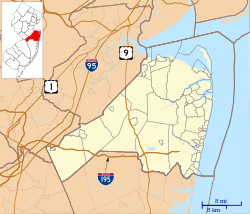Fort Hancock, New Jersey
|
Fort Hancock and the Sandy Hook Proving Ground Historic District
|
|

Fort Hancock Memorial Park
|
|
| Location | Sandy Hook, New Jersey |
|---|---|
| Coordinates | 40°27′50″N 74°00′10″W / 40.46389°N 74.00278°WCoordinates: 40°27′50″N 74°00′10″W / 40.46389°N 74.00278°W |
| Built |
|
| Architect | Capt. Robert E. Lee, United States Army Corps of Engineers |
| Architectural style | Third System (1857 fort), Endicott Program (Fort Hancock) |
| NRHP Reference # | 80002505 |
| Significant dates | |
| Added to NRHP | April 24, 1980 |
| Designated NHLD | December 17, 1982 |
Fort Hancock is a former United States Army fort at Sandy Hook in Middletown Township New Jersey. The coastal artillery base defended the Atlantic coast and the entrance to New York Harbor, with its first gun batteries operational in 1896. Between 1874 and 1919, the adjacent US Army Sandy Hook Proving Ground was operated in conjunction with Fort Hancock. It is now part of Fort Hancock Memorial Park. It was preceded by the Fort at Sandy Hook, built 1857–1867 and demolished beginning in 1885.
The Sandy Hook Light, built in 1764 and the oldest working lighthouse in the United States, is located on the grounds of Fort Hancock.
The Sandy Hook area was first fortified as part of the third system of US fortifications. Construction on the Fort at Sandy Hook began in 1857 and ceased in 1867, with the fort serviceable though largely incomplete. This fort was never officially named, but since the area was named Fort Hancock in 1895 it is often called by that name. It was sometimes locally called Fort Lincoln or Fort Hudson. Originally two tower forts were proposed, but a much larger single fort was decided on instead. The fort was designed by then-Captain Robert E. Lee of the Army Corps of Engineers. The fort was designed as a five-bastion irregular pentagon, with two tiers (one casemated, one barbette) of cannon totaling 173 guns on three seacoast fronts, with another 39 guns covering the landward approaches. As was common in Third System forts in the Northeast, it was built primarily of granite. At some point, with the casemate tier of the three seacoast fronts largely complete, the fort was redesigned to speed its overall completion, basically by eliminating the landward bastion and simplifying its neighboring bastions. Following the Civil War, it was determined that masonry forts were vulnerable to rifled guns, and funding for their construction was cut off in 1867. The fort remained incomplete until 1885, when almost all of it was cannibalized to build the Sandy Hook Proving Ground, the new Fort Hancock, and supporting structures such as a seawall. A small portion of one wall remains in place with four cannon ports.
...
Wikipedia

